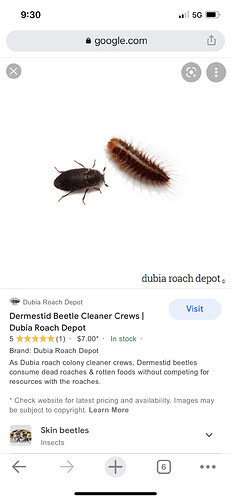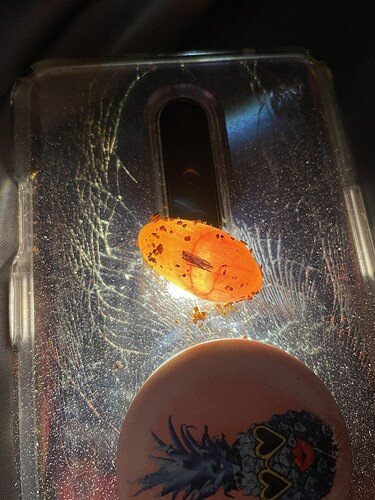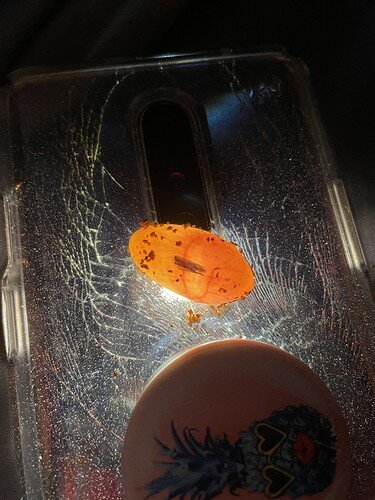In that case it’s nothing to worry about. It’s just dermestid beetle larvae which is commonly used in colonies to clean up frass (poop, exoskeletons, bodies, and other waste).
Well I’ll be honest and say they do a horrible job 
 and they should be fired because my crickets die fast lol I even keep an egg carton in there for them so they don’t squish each other.
and they should be fired because my crickets die fast lol I even keep an egg carton in there for them so they don’t squish each other.
Do you keep food in there at all times (wet food like veggies so there’s hydration and food). Also if you got adults they might only live for so long because of old age.
I keep the greenish water gel stuff and the little food crumbs fluker’s stuff. They just all die within like 2 days or 3 but maybe I’m putting too many in at a time
I’m not sure. However this post about keeping crickets might be helpful for how to keep them alive longer.
I know it’s been a while but I’m just wondering if anyone can help explain to me when I’ll see the baby itself in the egg  I haven’t been able to see it yet but it’s only been 2 weeks exactly. I think it’s doing well it’s very perfectly round and healthy and has lots of veins.
I haven’t been able to see it yet but it’s only been 2 weeks exactly. I think it’s doing well it’s very perfectly round and healthy and has lots of veins.
Thank you so much in advance!! 
I once had an egg, that I could never visibly see a embryo in… but it hatched one day!! So don’t lose hope 
It’s probably best to stop handling it, your hands could transfer toxins or pathogens you’re unawares of. You also risk desiccation when you repeatedly open an incubation container. And if you turn it, the embryo could drown.
This is a different kind of egg than most people are used to incubating and I don’t use an incubator I use my tank and it’s just in there in a container. Its an African fat tailed gecko egg not many people have successfully hatched them  but I think I can do it. And I candle it because I want to make sure it’s still alive but if need be I’ll lay off handling it.
but I think I can do it. And I candle it because I want to make sure it’s still alive but if need be I’ll lay off handling it.
I’m waiting for my first clutch from mine.
There are a lot of breeders about, so not hard to do, I got one of mine from a breeder in London, she’s a whiteout Zulu ‘white socks’ het Oreo, She’s brill, may be a bit on the chunk side…  . The pair together atm are striped amels! So can’t wait for them to lay!
. The pair together atm are striped amels! So can’t wait for them to lay!
What’s your pairing? 
AFT eggs are very similar to leopard gecko eggs. It’s also definitely not hard to breed them, they’re pretty common in the hobby. I have a Zulu Oreo Whiteout myself.
Just make sure you have an enclosure ready for the babies, and that they aren’t left to hatch in the tank. The risk of cannibalism or injury from the adults is very high for hatchlings and they cannot be kept with adults. You also might need different prey items for the babies, depending on what you are feeding.
The egg will most likely become opaque as the fetuses develop. Candling is really only a tool to use during the earliest stages to see if an egg is fertile and to make sure you put the egg right-side-up into the incubation media, it’s not really useful when it comes to development & is even possibly misleading if you’re inexperienced. That is what the Sharpie is for- because you won’t be able to tell which is right side up after the fetus is sizeable and obscures the light. If the egg goes bad it will dent, stink, and develop mold. I’m not sure what incubation times are for AFTs, but they are 30-90 days in leopard geckos, with colder incubation temps taking longer.
I already know all the information you just provided I used a sharpie to mark which way it was laid and canceling an egg will not harm it hence why it became a thing. Also it is in the early stages, two weeks old so I’m just trying to make sure it survives since this is my only egg that has, also you saying it’s easy to breed them yeah maybe for you but my female has been having a rough time with laying infertile eggs but this one egg is definitely good and I’m so proud  🥲 I do have one question though that I can’t find on the internet anywhere, how old do I wait for my baby to be after it hatched to use a heat lamp? I figure if they’re so commonly bred I’d find that on the internet but no luck
🥲 I do have one question though that I can’t find on the internet anywhere, how old do I wait for my baby to be after it hatched to use a heat lamp? I figure if they’re so commonly bred I’d find that on the internet but no luck 

My pair is two stripe that’s what they call them. And I’m from America Washington to be exact and obviously wherever everyone else is from they breed aft geckos more but it was hard for me to find them and I’ve only been told they’re hard to hatch and this is my first try ever hatching geckos I’m not a pro lol  like everyone else
like everyone else
Don’t worry about it too much, just keep incubating it until it molds or is obviously bad. It is a very good idea not to handle it too much or at all. Handling it will just decrease the chances of it hatching, the only reason to mess with it too much is to keep the conditions stable. African fat tails are harder to breed than leopard geckos but they aren’t too difficult, you still have a good chance.


